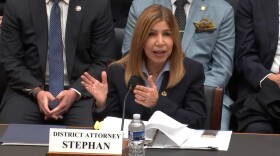The story of a new superintendent coming to town and shaking a school district up in the name of improving education is a familiar one. San Diego Unified's new superintendent, Cindy Marten, is basing her makeover of city schools on the theory that the key to school success is top-notch principals.
Marten went from being a reading teacher, to teacher leader, to principal. Then her career jumped off the beaten path; Instead of something like becoming a regional administrator, she was catapulted to superintendent by a unanimous vote of the board of education at the end of February, just one day after Bill Kowba, the district's then-superintendent announced his intention to retire at the end of the school year.
So Marten’s vision for reshaping the school district may not come as a surprise.
“I understand the role and the importance of the principal as the instructional leader and bringing a community together," Marten said. "We are focusing on the role of the principal and I believe my job is to support the principals.”
And a lot of principals will need support this year. Forty-two city schools have new leaders. That means about one in every five principals in the district is new to the job.
One of those new principals is Marco Drapeau. He left a vice principal position at Pacific Beach Middle School to take over Ocean Beach Elementary.
“I’d like to just get to know the culture of the school and the way the school runs," he said of how he's spending the first few weeks of school. "Every school has it’s own unique way of doing things.”
After each morning’s assembly, Drapeau tries to visit classrooms so he can be the kind of instructional leader Marten wants in district schools.
“We want to be in there to see what you’re doing right, to see what’s working well, how we can take those successful strategies that are in a particular classroom and get them across to the whole school. And that way, if I’m a teacher and I’m really strong at A, B and C but I know I need a little work on D. I can use the principal to say ‘Where’s someone doing something well with this?’"
Spending time in classrooms isn’t as easy as it sounds; there are a lot of other things principals have to do.
Every morning, Drapeau checks in with the school's custodian to see if any maintenance issues have popped up and to make sure that things are ready for any outside groups holding an event on campus that day.
Walking around campus, he motioned at the peeling paint on some of the walls.
“We’d like to get the whole school painted, because the building is actually pretty old," he said. "The actual buildings have been here 104 years.”
The afternoons, he said, he sets aside for paperwork. “There’s a couple of things that have to get done, especially at the beginning of the year, the compliance things — our site-based budget plan and single plan for student achievement.”
“It would be very discouraging to hear ‘Get in there, in the classroom as much as you can and take care of the other stuff,' and leave it at that," Drapeau said. "That would be very overwhelming.”
But helping principals, especially new principals, strike that balance between administrative and academic responsibilities is Tavga Bustani’s new job. She is in one of two new mentor principal roles Marten created this year.
“We launched the year with a series of workshops on student monitoring and what that would look like at a school site from a principal’s perspective,” she said.
Bustani is part of a new office for leadership development, all four staff members are former principals. She explained they’re there to make sure every school is using strategies that have been shown to be successful.
“The focal point of all of the research-based practices is really the quality and efficacy of the school leader," Bustani said. "So, how does a principal at a school site positively shape and influence teaching and learning in the classroom?”
Since those summer workshops Bustani has been following up with principals, especially new principals.
“I was at a site today, I was at a site yesterday. So it’s really trouble shooting and assisting and coaching principals after that learning that they experienced. And we’ll have consecutive sessions throughout the year based on need.”
In addition to strong school leaders, Bustani said the model for school success that the district is promoting includes each school cultivating a Professional Learning Community, which means teachers have dedicated time to collaborate on lessons and discuss what's working and what isn't. PLCs, as they're known by teachers and administrators, have been central to San Diego Unified's approach to improving schools for years.
The leadership development team is also focusing on helping principals develop instructional leaders, or teachers who specialize in and assist colleagues with specific curriculum areas, and with using student data to shape lesson planning and to celebrate student achievement.
Some research suggests that school leadership comes second only to the quality of classroom instruction when it comes to impacting student achievement. Bustani said that part of her job will be to help principals figure out how to mold the basics of what San Diego Unified is touting as the basis of school success for each of its more than 180 schools.
For Marten, another role of the leadership development office is not only changing principals' relationships with their staff, but giving them direct access to the district resources they need.
“We’re providing high-quality customer service for our principals," she said. "And the reason why we’re doing that on behalf of the principals is that we expect high quality service for our principals to have with their teachers and with the community members and you can’t deliver high-quality customer service by yourself — you’re not an island.”
Back in Ocean Beach, Marco Drapeau said he sees those efforts making a difference. At one of the summer training institutes, he met the man who handles physical plant issues for coastal schools and got his cell phone number. Drapeau called him directly when a student with special physical needs enrolled.
“People just kept showing up, bringing stuff, installing stuff and just kept – and we were all very like ‘Wow. This is awesome.' Because a lot of times, it didn’t work that way. A lot of time it was : you put in a call, and you wait for this, then somebody else has got to look at it and they’re going to approve it later. And it was a lot of layers," he said.
The new principal-centered approach is a work in progress. But so far, Drapeau said he’s encouraged.






